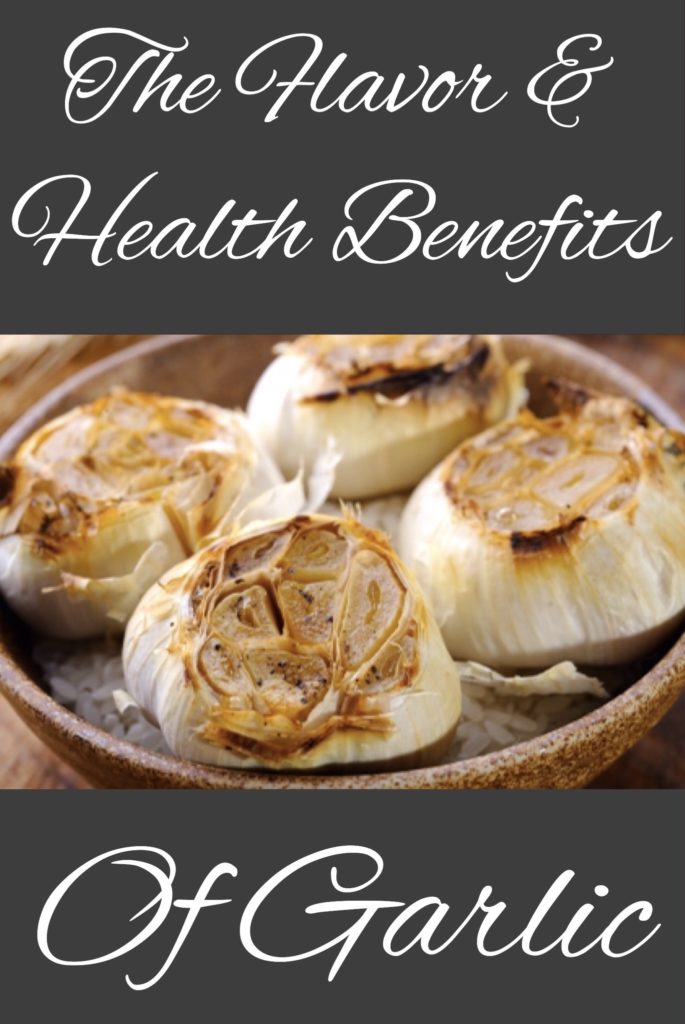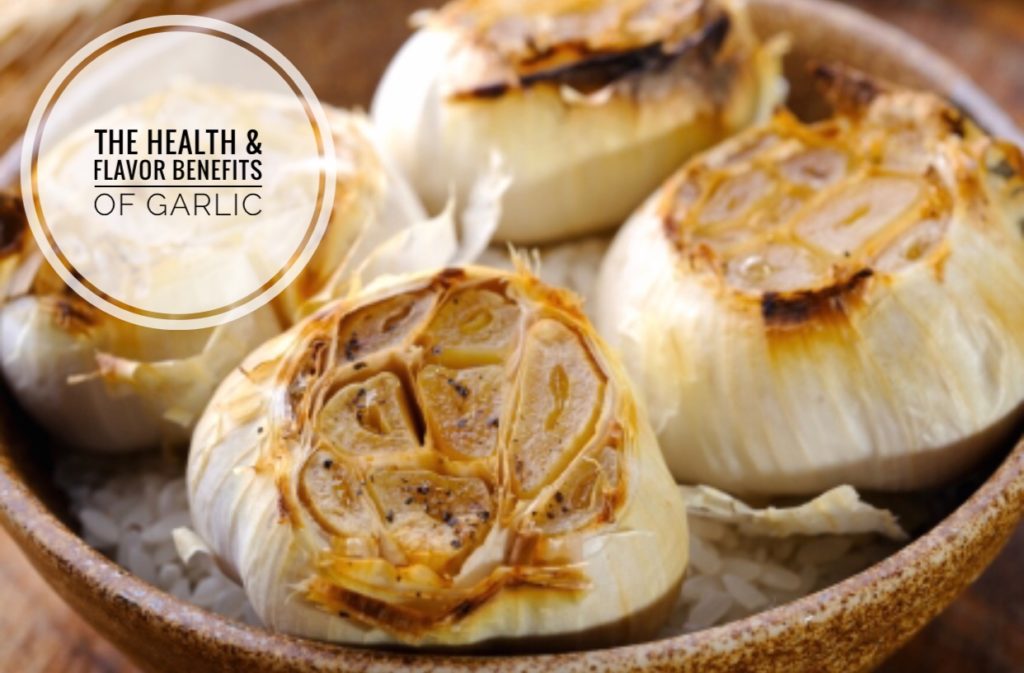Garlic adds lots of flavor to food, but it has more to offer than that. Learn the nutrition and health benefits of garlic plus a recipe for making fresh roasted garlic.

A couple weekends ago I volunteered with the Greater Pittsburgh Community Food Bank for the Annual Red, Ripe, and Roasted Festival at Phipps Conservatory in Oakland. It was a wonderful festival highlighting tomatoes and garlic, that consisted of food demos, children’s activities, a tomato contest, and of course all the tomato and garlic you could imagine.
All afternoon, while taking a break from my volunteer duties, I was able to sample a number of different snacks – gazpacho, garlic scape pesto, fresh sun gold tomatoes, and even fried green tomatoes. My favorite by far was fresh roasted garlic.
What Is Garlic?
Garlic is an herb that is similar to onion, leeks and chives. Most of us think of garlic as a way to add flavor to food. It’s great fresh and roasted, but can also be purchased as garlic powder alone or in seasoning mixes, or as an oil. Garlic is much more than a flavoring agent, though. According to the National Center for Alternative and Complementary Medicine, and the National Institute of Health’s MedlinePlus , supplementing the diet with garlic may have some health benefits, too.
Potential Health Benefits of Garlic
Throughout history, garlic has been used for both culinary and medicinal purposes. Historically, it was used during both world wars to prevent gangrene. Research on this herb began with the study of its antibacterial activity back in the 1930’s. Today, it has been studied for its potential in helping and slowing the progression of many chronic diseases.
Atherosclerosis and Blood Pressure
Atherosclerosis is a chronic condition in which the arteries begin to harden and narrow. This happens naturally as we age, but genetic, diet and lifestyle play a big role in how quickly the progression happens. Basically, our arteries tend to lose their ability to stretch and flex as we get older. Studies have also investigated garlic’s impact on blood pressure. Some research has shown that taking garlic orally can modestly reduce blood pressure in those that have high blood pressure, as well as those that do not.
Prostate Cancer
Scientists have also investigated the effect that garlic has on prostate cancer. While study results are mixed, preliminary research suggests that taking garlic supplements could reduce the risk of developing prostate cancer. Other preliminary evidence investigated garlic extract, showing potential support with symptoms associated with the disease.
Allicin – The Defense Molecule in Garlic
Garlic contains a natural, chemically active compound referred to allicin. It’s that compound we have to thank for the taste and smell experienced from freshly cut or crushed garlic. Basically, it is guilty of giving us garlic breath. Allicin is also responsible for many different biological properties that occur in the body.
According to researchers, allicin is the compound almost exclusively responsible for antimicrobial activity of freshly chopped garlic. I’ll spare you the biochemistry lesson on how it works, but you can read more about allicin’s chemistry and biological properties here if you are interested. Just know that, in my opinion, this physiologically active molecule is worth consuming!
Though we need much more research to understand the true potential for human health, it can’t hurt to start consuming it!
So now with a little background, what are you waiting for? Do your body and your taste buds good, and check out just how easy it is to make some fresh roasted garlic!

Roasted Garlic Recipe
- Prep time: 5 minutes
- Cook time: 30 minutes
Instructions:
- Preheat the oven to 400°F.
- Peel away the outer layers of the garlic bulb skin, leaving the skins of the individual cloves intact. Using a knife cut off ¼ to a ½ inch of the top cloves, exposing the individual cloves of garlic.
- Place the garlic heads in a baking pan; muffin pans work well for this purpose. Drizzle a couple teaspoons of olive oil over each head, using your fingers to make sure the garlic head is well coated. Cover with aluminum foil. Bake at 400°F for 30-35 minutes, or until the cloves feel soft when pressed.
- Allow the garlic to cool enough so you can touch it without burning yourself. Using a small knife cut the skin slightly around each clove. Use a cocktail fork or your fingers to pull or squeeze the roasted garlic cloves out of their skins.
- Eat as is or mash with a fork and use for cooking. Can be spread over warn French bread, mixed with sour cream for a topping for baked potatoes, or mixed in with Parmesan and pasta.
*Recipe from simplyrecipes.com
Interested in more ways to add flavor and nutritional beenfits to your food? Check our my post on ginger that explains why it’s more than just a spice.
Additional References:
National Center for Complimentary and Alternative Medicine. Herbs at a Glance: Garlic. Available at: http://nccam.nih.gov/health/garlic/ataglance.htm. Accessed September 10, 2011.


 Hi, I’m Heather – a registered dietitian, busy mom, consultant, adventure junkie and travel addict who has mastered living healthy on the go. My blog is where I share simple recipes and healthy living tips to help and inspire others to live their best life.
Hi, I’m Heather – a registered dietitian, busy mom, consultant, adventure junkie and travel addict who has mastered living healthy on the go. My blog is where I share simple recipes and healthy living tips to help and inspire others to live their best life.